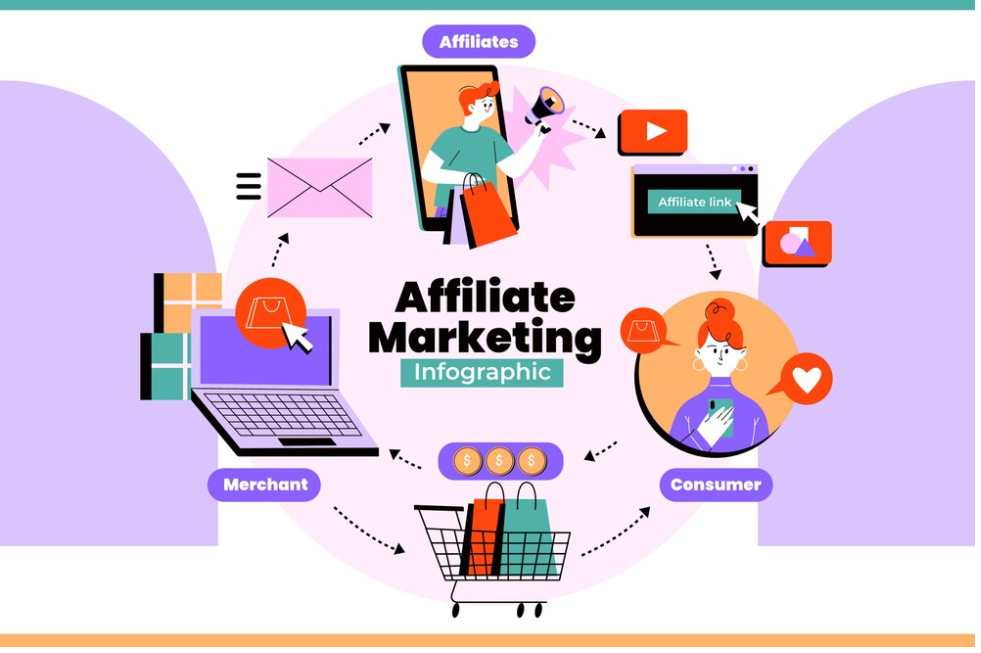- May 21, 2024
- abdulazeem325566
- (0)
- Affiliate Marketing, Uncategorized
Understanding Affiliate Marketing

Affiliate Marketing is a dynamic and multi-faceted process, involving various parties and methodologies to achieve successful outcomes. Here’s a closer look at its core components:
Key Players in Affiliate Marketing:
- Sellers and Product Creators: The originators of the products or services being marketed.
- Affiliates or Advertisers: Individuals or companies that promote the products or services in exchange for a commission.
- Consumers: The end-users who purchase the products or services through affiliate links.
- Affiliate Networks: Serve as intermediaries between merchants and affiliates, facilitating the management of affiliate programs and transactions.
- Types of Affiliate Marketing:
- Unattached: Affiliates have no connection to the product or service they are promoting.
- Related: Affiliates promote products or services related to their niche or industry.
- Involved: Affiliates have personal experience and endorse the products or services they promote.
- Commission Structures:
- Pay Per Sale (PPS): Affiliates earn a commission when a sale is made through their referral link.
- Pay Per Lead (PPL): Affiliates are compensated when they refer leads that take a specific action, like signing up for a trial.
- Pay Per Click (PPC): Affiliates receive payment based on the number of clicks generated from their referral links to the merchant’s website.
- Pay Per Install (PPI): Affiliates earn when a consumer installs an app or software from their referral.
Understanding these fundamental aspects of affiliate marketing underscores its legitimacy and potential as a lucrative marketing strategy.
Getting Started with Affiliate Marketing

Embarking on the affiliate marketing journey begins with selecting a niche that resonates with personal interests and market needs. This crucial step ensures that affiliates engage with their audience authentically and sustainably. Following a systematic approach can streamline this process:
- Niche Selection:
- Personal Interests: Start by listing areas you are passionate about. This ensures long-term engagement and authenticity in content creation.
- Market Demand: Research potential profitability and demand for the selected niches. Tools like Google AdWords and ClickBank offer insights into niche viability and monetization options .
- Competition Analysis: Understanding the competitive landscape helps in identifying niches with enough demand yet not oversaturated.
- Platform and Content:
- Decide on a Content Platform: Whether it’s blogging, YouTube, or social media, choose a platform that matches your strengths and audience preferences .
- Content Creation: Focus on generating high-quality, relevant content that addresses the needs and interests of your target audience. This builds trust and drives traffic .
- Affiliate Program Selection:
- Research: Look for affiliate programs that align with your niche and have a reliable track record .
- Commission Rates: Prioritize programs offering competitive commissions to maximize earnings.
- Terms and Conditions: Understanding the program’s terms is crucial to avoid scams and ensure a fair partnership.
By following these steps, affiliates can lay a solid foundation for a successful affiliate marketing venture, ensuring alignment with personal interests, market demand, and profitable partnerships.
Strategies for Successful Affiliate Marketing

To pave the way for successful affiliate marketing, understanding and applying diverse strategies tailored to your audience and niche is essential. Here’s a breakdown of proven strategies:
- Content Creation & Transparency:
- Focus on creating in-depth, smart, and relevant content that delivers value beyond mere product promotion .
- Be transparent about your affiliate relationships and provide honest opinions on the products or services you recommend .
- Align your promotions with products or services that resonate with your values and meet your audience’s needs .
- Optimization & Engagement:
- Utilize SEO, paid traffic, and email marketing to enhance visibility and attract potential customers.
- Engage your audience by encouraging conversations and providing help rather than overt selling .
- Continuously test and improve your strategies, including conversion optimization techniques like button placement and the use of visuals .
- Partnerships & Audience Understanding:
- Partner with influencers for a higher return on investment and leverage coupon deals to attract new customers .
- Understand your audience deeply, focusing on quality leads by promoting established products from reputable brands .
- Innovate in reaching new audiences, for instance, through YouTube video reviews, and always prioritize your audience’s interests .
Choosing the Right Affiliate Programs

Choosing the right affiliate programs is pivotal in steering your affiliate marketing journey towards success. Here are key considerations and steps to guide you through this crucial process:
- Interest and Expertise: Start with what you know and love. Your passion and knowledge in a niche can translate into compelling content and authentic promotions. Successful affiliates like Pat Flynn and Michelle have thrived by aligning their interests with their affiliate endeavours.
- Profitability and Demand: Evaluate potential niches by considering factors such as market demand, scalability, and competition. High-demand niches like technology, health and wellness, and finance often offer lucrative opportunities. However, it’s also essential to assess the competition and find a unique angle or USP for your content.
- Quality and Reliability of Products: Partnering with reputable companies that offer high-quality products is non-negotiable. Always research products, read reviews, and, if possible, test them yourself before recommending them to your followers.
By meticulously selecting affiliate programs that align with your interests, market demand, and quality standards, you can build a sustainable and profitable affiliate marketing business.
Avoiding Common Affiliate Marketing Mistakes

To navigate the complex landscape of affiliate marketing successfully, avoiding common pitfalls is crucial. Some mistakes are here to know:
- Quality Over Quantity:
- Content: Prioritize producing high-quality, well-researched content over quantity. Engage your audience with valuable insights rather than overwhelming them with low-quality posts .
- Product Selection: Focus on promoting a few high-quality products that resonate with your audience’s needs, rather than a vast array of items.
- Technical and SEO Considerations:
- Website Performance: Enhance site speed using tools like GTMetrix and Cloudflare CDN to improve user experience and reduce bounce rates.
- SEO Practices: Implement basic SEO strategies, including optimizing title tags, meta descriptions, and utilizing internal and external links to boost visibility and credibility .
- Ethical and Strategic Practices:
- Transparency: Always disclose affiliate partnerships to build trust with your audience. Transparency about commissions earned from recommendations is not only ethical but also fosters a sense of honesty and reliability.
- Diversified Traffic Sources: While organic traffic is vital, exploring additional monetization methods such as sponsored content or digital products can enhance your reach and revenue .
Expanding Your Affiliate Marketing Efforts

To effectively expand your affiliate marketing efforts, consider the following strategies and tools:
Optimize for Conversion and Traffic Quality:
- Focus on the quality of traffic rather than just quantity. Analyze conversion rates of landing pages or offers to ensure you’re attracting the right audience .
- Use tools like Ahrefs for keyword research and competitor analysis to target high-quality traffic sources .
- Implement Rank Math for optimal on-page SEO, ensuring your content ranks well and attracts targeted traffic .
- Enhance Affiliate Relationships and Resources:
- Recruit the right affiliates by providing them with necessary resources and support during the onboarding process .
- Maintain regular communication through affiliate managers and newsletters to share insights and strengthen relationships .
- Provide affiliates with collateral and resources, like Thirsty Affiliates for link management, to aid their promotional efforts .
- Strategic Expansion and Collaboration:
- Scale your business by promoting a range of products within the same niche to maximize value from each lead.
- Develop partnerships with complementary businesses to cross-promote offerings to a wider audience .
- Encourage affiliates to include your business in comparison articles, leveraging platforms like Google Analytics for crucial data and analytics to guide strategy .
Conclusion
Throughout this exploration of affiliate marketing, we’ve uncovered its legitimacy and potential as a lucrative digital strategy. We delved into its foundational elements, from understanding the key players and commission structures to selecting viable niches and effective platforms for content delivery. These efforts have shown that, with the right approach and commitment, affiliate marketing offers a genuine pathway to generating income online, backed by substantial growth projections and adoption by leading industry players.
In moving forward, it’s essential for aspiring affiliates to heed the discussed strategies and avoid common pitfalls, ensuring they’re building on a solid foundation of quality content, ethical practices, and continuous optimization. While the landscape of affiliate marketing continues to evolve, the principles of transparency, audience engagement, and strategic program selection remain crucial for success. This arena is ripe for those willing to invest their time and resources, promising not just financial returns but also the opportunity to flourish in the expansive world of digital marketing.
.
Pros and Cons
Pros
Passive Income Potential
One of the key benefits of affiliate marketing is its potential for generating passive income. Once set up, affiliate marketing campaigns can continue to generate revenue with minimal ongoing effort, allowing affiliates to earn money while focusing on other aspects of their lives or businesses.
Low Start-up Costs
Affiliate marketing typically requires minimal upfront investment, making it accessible to individuals with limited financial resources. Affiliates can get started with little to no capital, as they don’t need to create their own products or invest in inventory.
Flexibility and Freedom
Affiliate marketing offers unparalleled flexibility and freedom, allowing affiliates to work from anywhere with an internet connection. They can choose their own hours and determine how much time and effort they want to invest in their affiliate marketing endeavors.
Scalability
Affiliate marketing is highly scalable, allowing affiliates to increase their earnings by scaling their promotional efforts. As they gain experience and refine their strategies, affiliates can expand their reach and maximize their earning potential.
Diverse Income Streams
Affiliates have the opportunity to advertise products or services from a range of companies spanning diverse industries. This approach allows them to broaden their income sources and diminish dependence on any one revenue stream..
Cons
Competition
The affiliate marketing landscape is highly competitive, with countless affiliates vying for the attention of consumers. Standing out in a crowded marketplace can be challenging, requiring affiliates to differentiate themselves and develop unique value propositions.
Dependence on External Platforms
Affiliate marketers often rely on external platforms, such as social media networks or search engines, to reach their target audience. Changes to these platforms’ algorithms or policies can impact affiliates’ ability to reach potential customers and generate revenue.
Revenue Volatility
Affiliate marketing income can be volatile, as it is subject to fluctuations in consumer demand, market trends, and product availability. Affiliates may experience periods of feast and famine, making it necessary to maintain financial stability and plan for lean times.
Reputation Risks
Affiliate marketers risk damaging their reputation if they promote low-quality products or engage in unethical marketing practices. Building trust with their audience is crucial for long-term success, and affiliates must prioritize transparency and authenticity in their promotional efforts.
Regulatory Challenges
Affiliate marketing is subject to various regulations and legal requirements, including disclosure guidelines and consumer protection laws. Affiliates must ensure compliance with relevant regulations to avoid fines, penalties, or legal consequences.
FAQs:
A: Absolutely, affiliate marketing is a legitimate and profitable method to earn money online. It involves genuine transactions among real customers, affiliates, and brands. While it’s not a shortcut to wealth, it demands dedication, effort, and a willingness to learn.
A:. Despite some skepticism from those less familiar with it, affiliate marketing is a bona fide way to generate income. With the vast majority of people connected to the internet and online sales continually rising across various categories, it’s a viable option.
A: Certainly, affiliate marketing is a trustworthy and potentially lucrative business model. It relies on authentic interactions between real customers, affiliates, and companies. It’s not a scheme for instant riches or a fraudulent practice, but it does require real work, commitment, and a learning curve.
A: Yes, there are individuals who have amassed significant wealth from affiliate marketing, with some top affiliates earning in excess of $100,000 per month. Success in this field hinges on putting in the necessary effort, having patience, and maintaining consistency. Choosing a niche that aligns with your interests is also crucial for success.


Leave a Reply